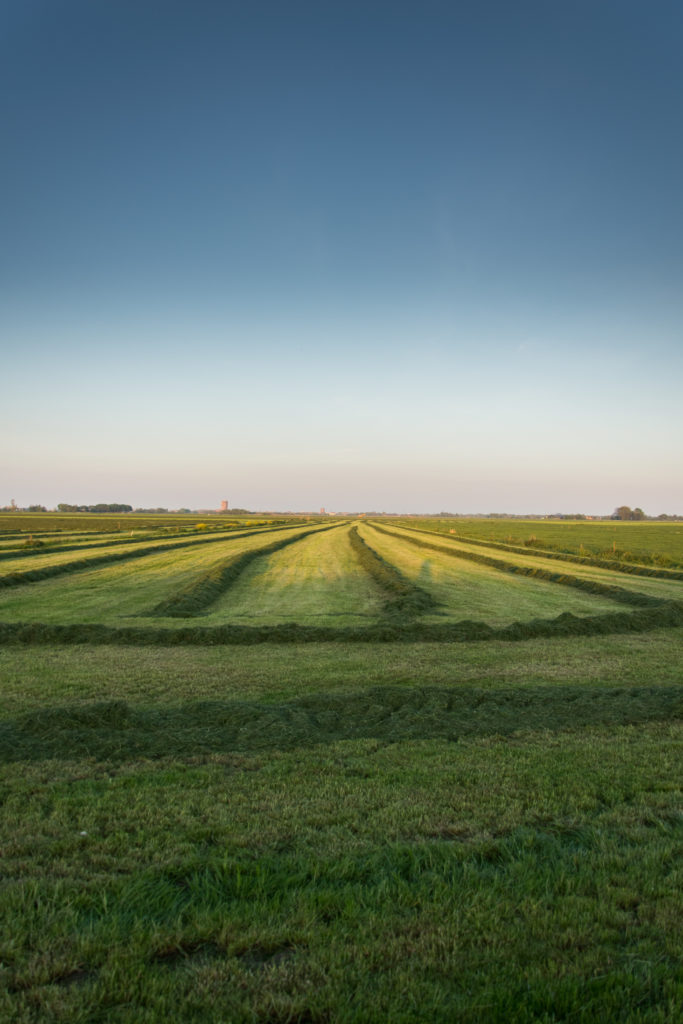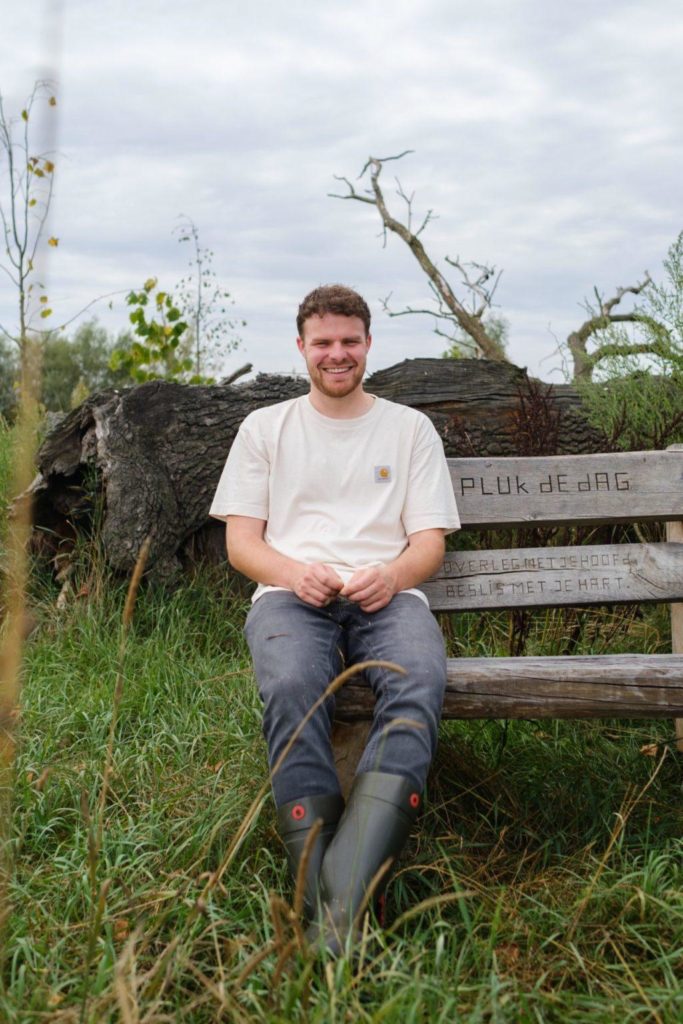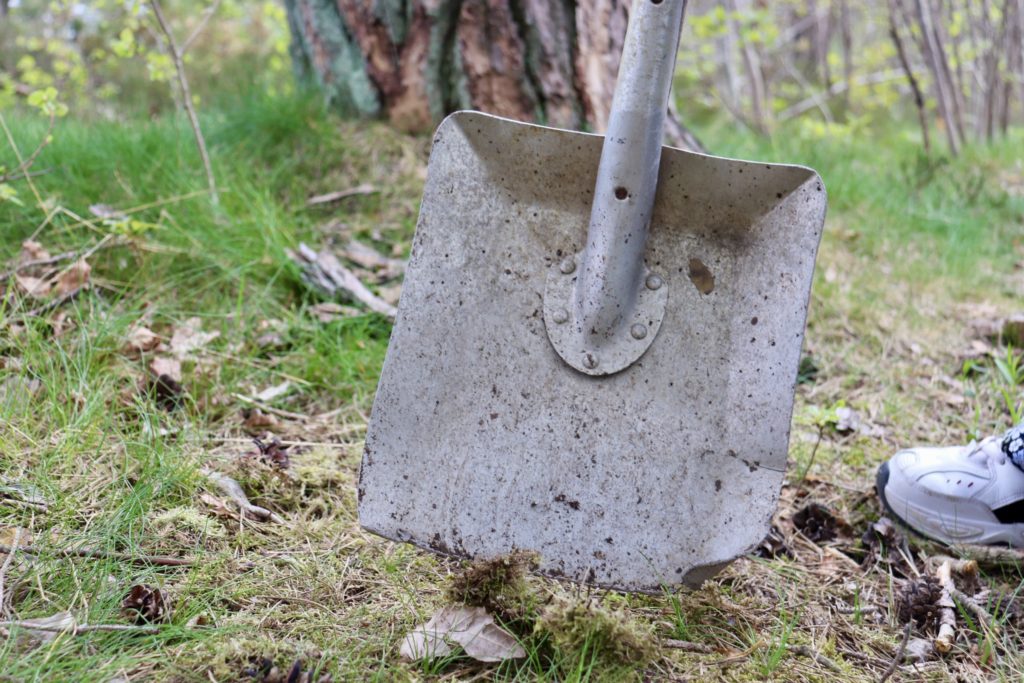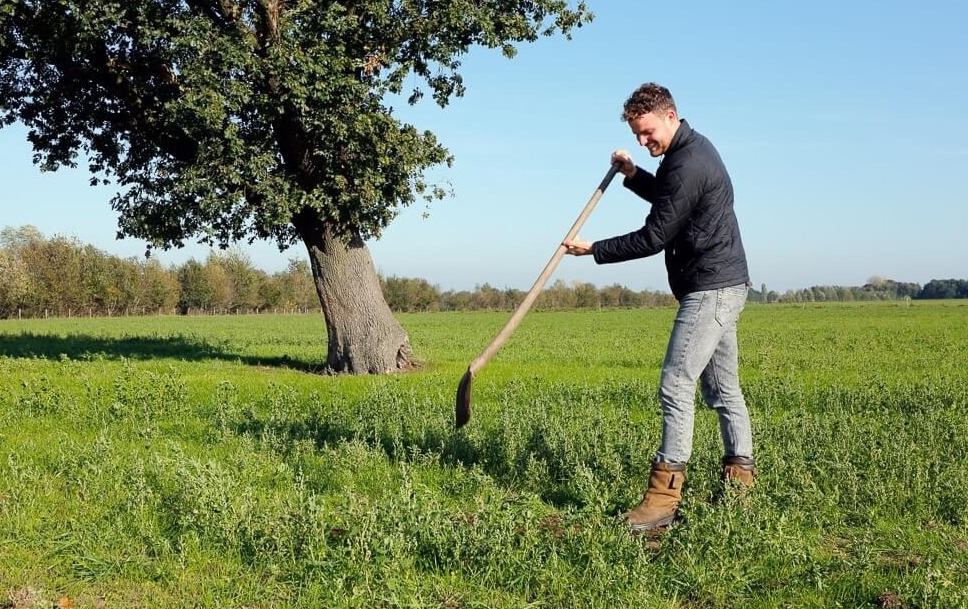Photo caption: Farmer Mark Venner planting trees on his land. Photo: Branko de Lang.
Author: Suzanne Vink
This article is originally in Dutch.
There is an urgent need for trees in our fight against climate change. However, the goal of 10 percent more forest in 2030 is highly unlikely to be achieved. Insufficient space, expensive land, and growing forests is becoming increasingly challenging due to climate change.
Wide green fields crossed by ditches, grazing black-and-white cows, a farmer on a tractor in the distance, and you can see for kilometers until the horizon: the ‘polder’. However, farmer Mark Venner is worried: “Where is the biodiversity? It really upsets me that you can see so far without a single tree blocking the view. Where are they?”

163 million. That’s approximately the number of trees in the Netherlands. It may sound like a lot, but that’s not the case. When you look at the percentage of forest, it’s low: only 9.9 percent of the Dutch surface area is covered by forests. Only Malta has less forest, primarily because trees struggle to grow in many places there. In the Netherlands there’s a different reason: we have a significant amount of agricultural land, leaving no space for forests.
Deforestation faster than in the Amazon
Until 2013, the amount of forest in the Netherlands was growing, but since then, deforestation has been taking place. Between 2013 and 2017, deforestation was even happening at a faster rate than in the Amazon region. Bas Lerink, a researcher on European forests at Wageningen University: “Of course, this is relative: the scale in the Amazon is entirely different, but deforestation in the Netherlands was also happening very rapidly.”
The reason for this deforestation was land use conversion. “Sometimes it was transformed into other forms of nature, but occasionally into infrastructure or urban areas”, says Lerink.
10 percent more forest in 2030
The Ministry of Agriculture, Nature and Food Quality (LNV) together with the provinces created the Forest Strategy in 2020: plans to plant more trees in the Netherlands and improve the quality of the forests. One of the goals is to have ten percent more forest by 2030. By planting these trees, carbon dioxide (CO2) is captured, which is crucial in the fight against climate change. These measures also have an impact on achieving national, European, and global climate agreements.
“You need to plant more to achieve the goal because many trees also die over time”
Bas Lerink, European forests researcher at Wageningen University
Ten percent more forest means that an additional 37.000 hectares of forest need to be planted, and according to Lerink, even more: “You need to plant more to achieve the goal because many trees also die over time.” Some of the trees will be planted within the Nature Network Netherlands (NNN), the existing nature areas, while others will be planted outside of it. Bas Lerink: “For example, alongside roads, in combination with agriculture, near residential areas, or in places where wind turbines are located. There are numerous situations with win-win possibilities where we can plant trees.”

The polder is a monoculture
Mark Venner is a farmer who has created such a win-win situation. He grew up on a dairy farm, but his passion lay elsewhere: “During my studies in Nature and Forest Management, I learned a lot about biodiversity and the importance of nature. I didn’t see that reflected in agriculture; there, you mostly see monoculture.”
Therefore, he decided to explore other options, which led him to the concept of a food forest. He planted over 30.000 trees on his land. “The currently young forest will eventually develop into a food factory with edible trees, plants, and shrubs”, he explains. This farming method is called agroforestry and is also encouraged in the Forest Strategy as a way to incorporate more trees into the Dutch landscape.
Unattainable goal
Ten percent more forest in 2030 is a clear goal, but there are more voices indicating that the goal will not be achieved. Frits van Beusekom, former director of Staatsbosbeheer, the Dutch State Forest Service, has been critical of the current forest policy in the Netherlands. He is also critical of this goal: “It would be wonderful if it could be achieved, but it is not feasible. They already knew this when setting the goal; it sounds good for the public.”
Lesson from the past
Mart-Jan Schelhaas, a researcher in forest damage and forest conservation at Wageningen University, finds it to be a commendable goal but believes that achieving it will be challenging. He refers specifically to previous forest expansion plans: “They have never been achieved.”
An example is the ‘Forest Policy Plan’ from 1993, which aimed to realize 75.000 hectares of forest by 2020. This target was not met due to high land prices. The current forest area of approximately 363,000 hectares (2021) is roughly the same level as in 1990, showing no growth.

Too slow
Less than seven years left until the deadline. Bas Lerink: “Progress has been slow. If you look at the situation now, achieving a ten percent increase by 2030 will be a challenging task.” In February 2023, Probos published a report on the current state of the Forest Strategy, estimating that only 1000 hectares of the targeted 37.000 have been realized, with the majority located within the Nature Network Netherlands. To stay on track, this number should have been at least ten times higher. Probos: “More effort is needed to achieve the goals.”
Lerink mentions that the slow progress is mainly due to slow decision-making, difficulties with permits, and financial constraints. Additionally, he emphasizes that establishing forests is more challenging than people think: “It may sound simple, just planting some trees and letting them grow. But due to drought and acidification, it is becoming increasingly difficult to grow forests.”
Cindy Heijdra, spokesperson for the Minister for Nature and Nitrogen, explains that the pace is not very high due to competition for space and issues related to finances. “We expect that forest expansion will accelerate in the coming years, as the first years have mainly involved preparatory steps.”
Land value
Finances are also a stumbling block. The General Court of Audit, in its report ‘Forest Management in Perspective‘ (2022), expects that the goal will not be achieved, with the cost of land being the main reason. Expanding forests outside of existing nature areas (Nature Network Netherlands) will be challenging because the financing for it has not yet been arranged.
“Some farmers are willing to plant forests, but it is not at all attractive due to the depreciation of land value”
Mart-Jan Schelhaas, researcher in forest damage and forest conservation at Wageningen University
“The main issue is that when you plant a forest, the value of the land decreases”, says Schelhaas. Agricultural land costs an average of 79.000 euros per hectare, but when it becomes forest land, the value decreases by about 20.000 euros per hectare. In addition, there are planting costs of 13.750 euros and missed income from agriculture. “Some farmers are willing to plant forests, but it is not at all attractive due to the depreciation of land value”, according to Schelhaas.

Asking a lot from farmers
Food forest farmer Mark Venner has indeed transformed his land and sees it as a good way to plant more trees. However, he also acknowledges that farmers are asked to do a lot: “Planting does indeed cost a lot of money, there is a lot of maintenance in the early years, and a food forest does not immediately generate a lot of income.”
He solved this problem by organizing a crowdfunding campaign. “But that is not the ultimate solution and not possible for every farmer. This obstacle could be addressed through more initiatives and foundations providing financing, or more subsidies from the provinces.”
More collaboration and subsidies
Cindy Heijdra from the ministry indicates that the issue with financing will become less significant because the Forest Strategy has been included in the National Rural Area Programme (NPLG). “There is visibility of more financing.”
According to Schelhaas, subsidies could be a solution, as well as increased collaboration with pension funds and companies that are willing to invest in tree planting. “They can do so as compensation for their own CO2 emissions.” Currently, there is no established platform connecting companies to forest expansion projects.
Scarcity of space for trees
“It’s really a challenge to find space, the Netherlands is densely populated,” says Schelhaas. He indicates that the provinces can have an influence on this matter: “So far, there are indications that this goal is not a high priority for the provinces.” The General Court of Audit also recommends that the Minister of Agriculture, Nature and Food Quality address the provinces’ responsibility to achieve the goal.
All provinces have published their versions of the forest strategy. Probos has compiled this information, and it shows that collectively the provinces aim to plant 29.852 hectares of forest. There is still a gap of about 7000 hectares. In response to this, the ministry states that the allocation will be further refined over time. “The aim is for this process to result in a final allocation in the first quarter of 2023.”
Too many obstacles
The goal for 2030 faces many obstacles and is likely not to be achieved. Mart-Jan Schelhaas: “There is no single responsible party. The ambitions have been formulated, but the financing, coordination, and space are lacking. The government should develop a larger and clearer plan for it.”
Cindy Heijdra states that the ministry still expects to achieve the goal by 2030. She says, “With the steps that have been taken so far and with a strong commitment together with the provinces, we believe that the goals are within reach.” When asked about the alternative if it seems that the goal will not be met, Heijdra responds: “We are currently working closely with the provinces to address potential barriers, and we will continue to do so.”

Mark Venner planted his food forest in 2020, which means that the trees are still small. It will take several more years before he can harvest for the first time. “The forest grows slowly.” He hopes to inspire other farmers with his food forest: “This is innovative agriculture in a sustainable way, where you also sequester CO2 and help the climate. It’s a win-win situation, isn’t it?”
This article is part of “Crossborder Journalism Campus”, an Erasmus+ project of the University of Gothenburg, Leipzig University and Centre de Formation des Journalistes in Paris. Additional reporting: Heino Ollin, Peter Seenan, Sandra Daniel and Ella Daneshmand.

